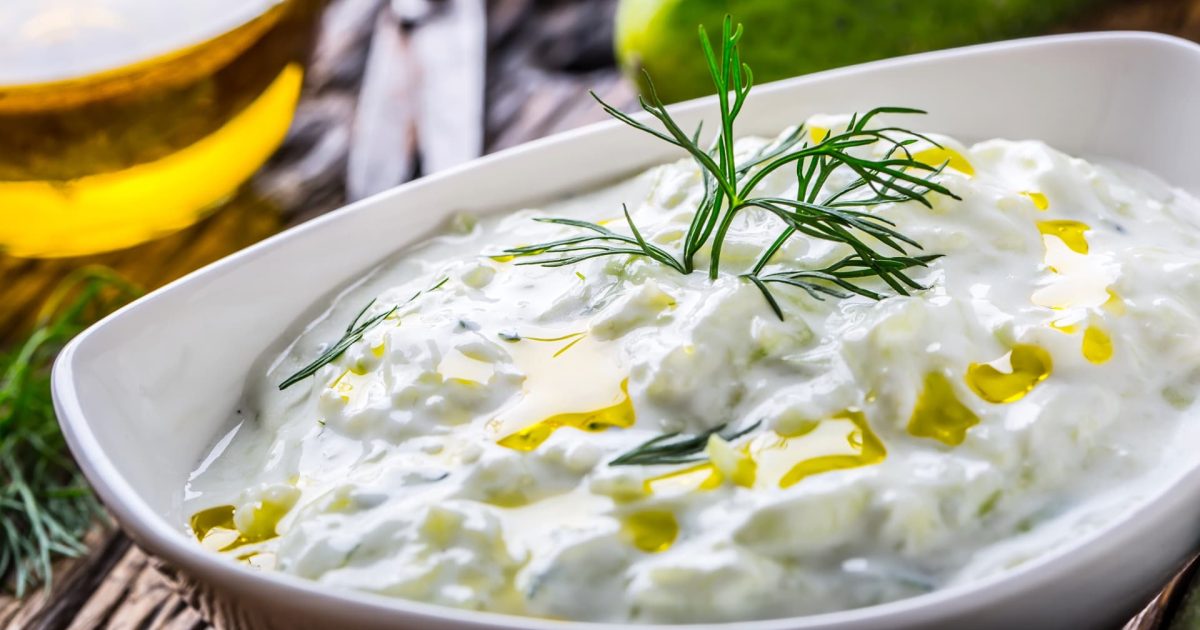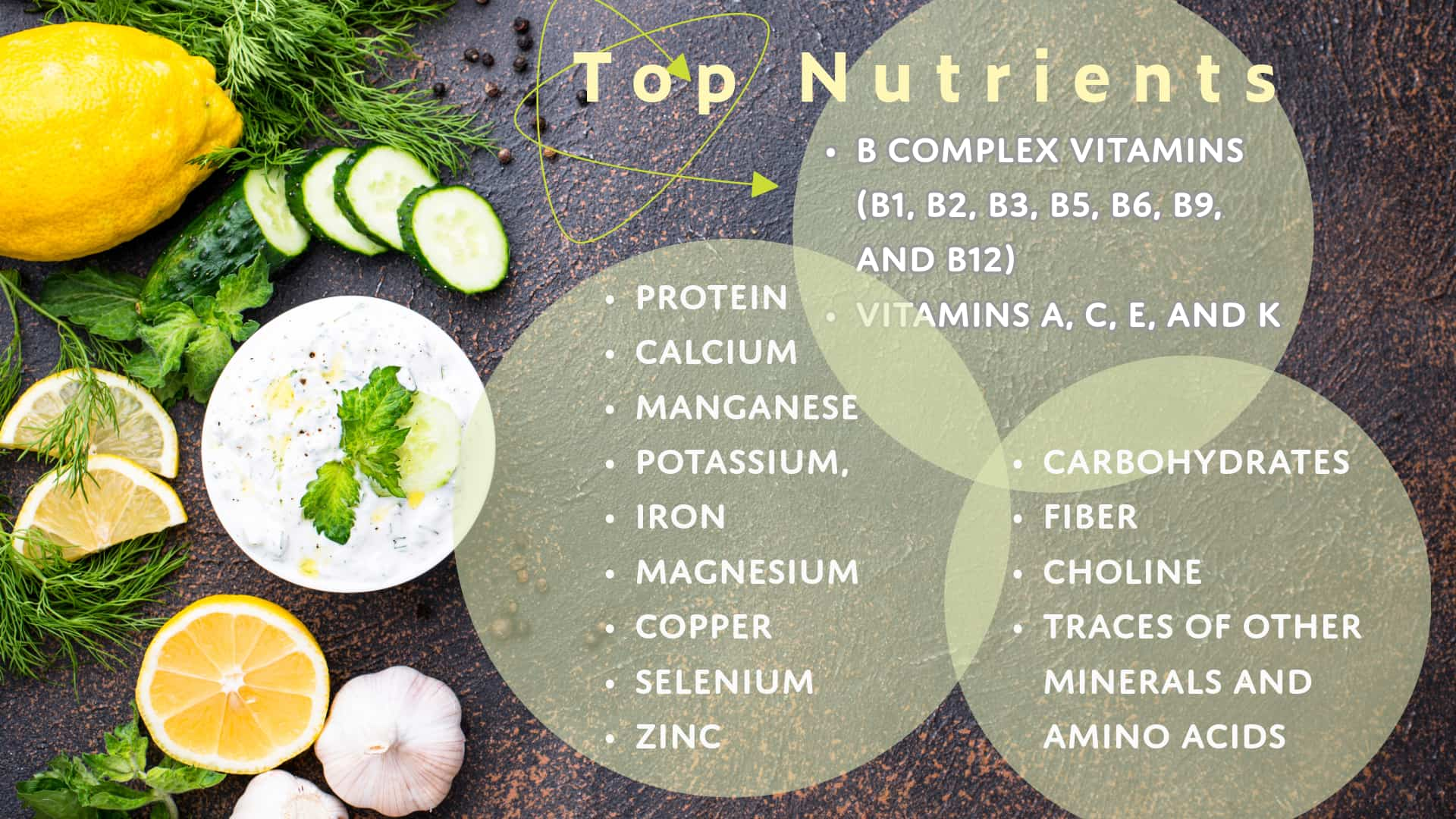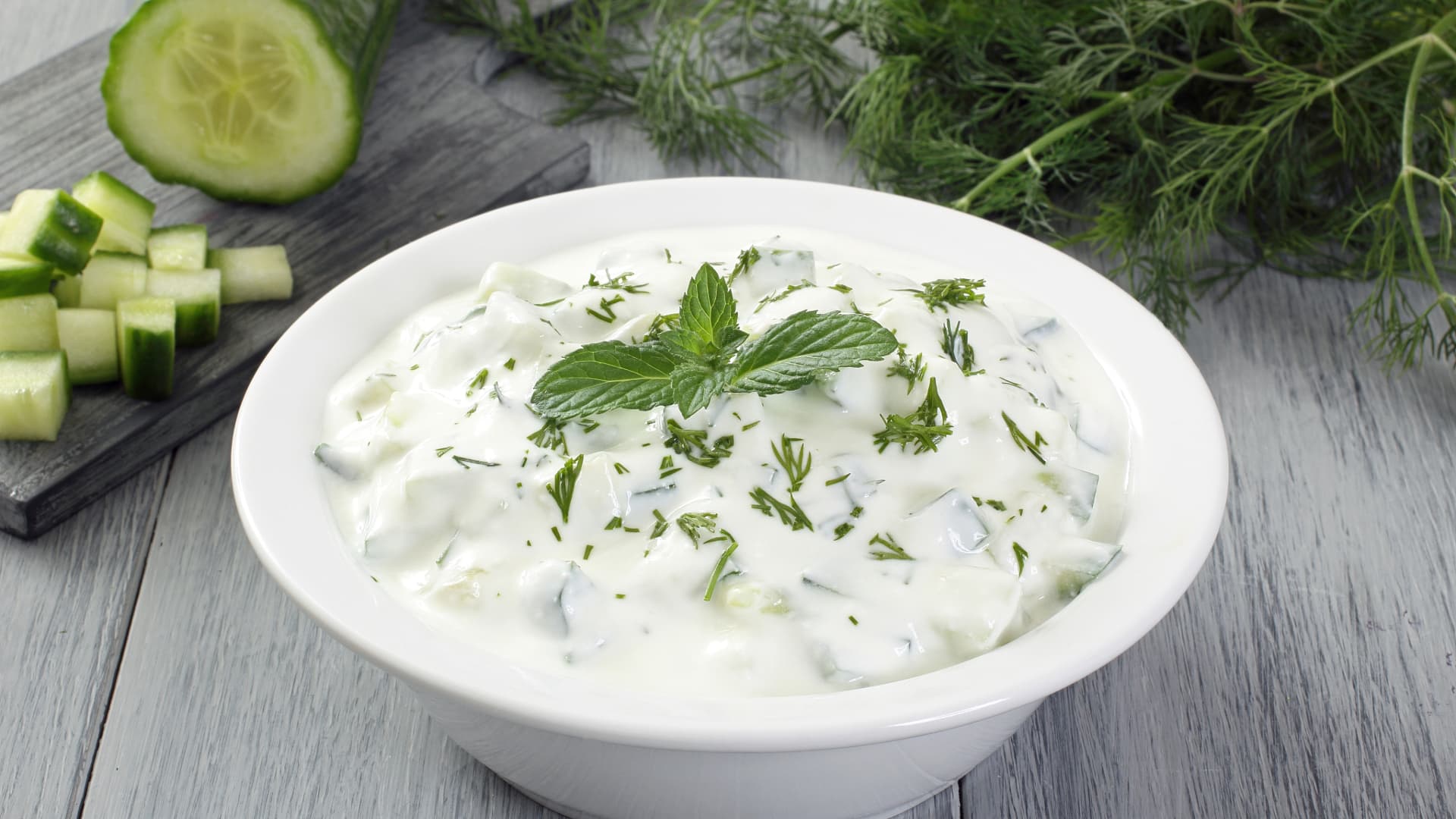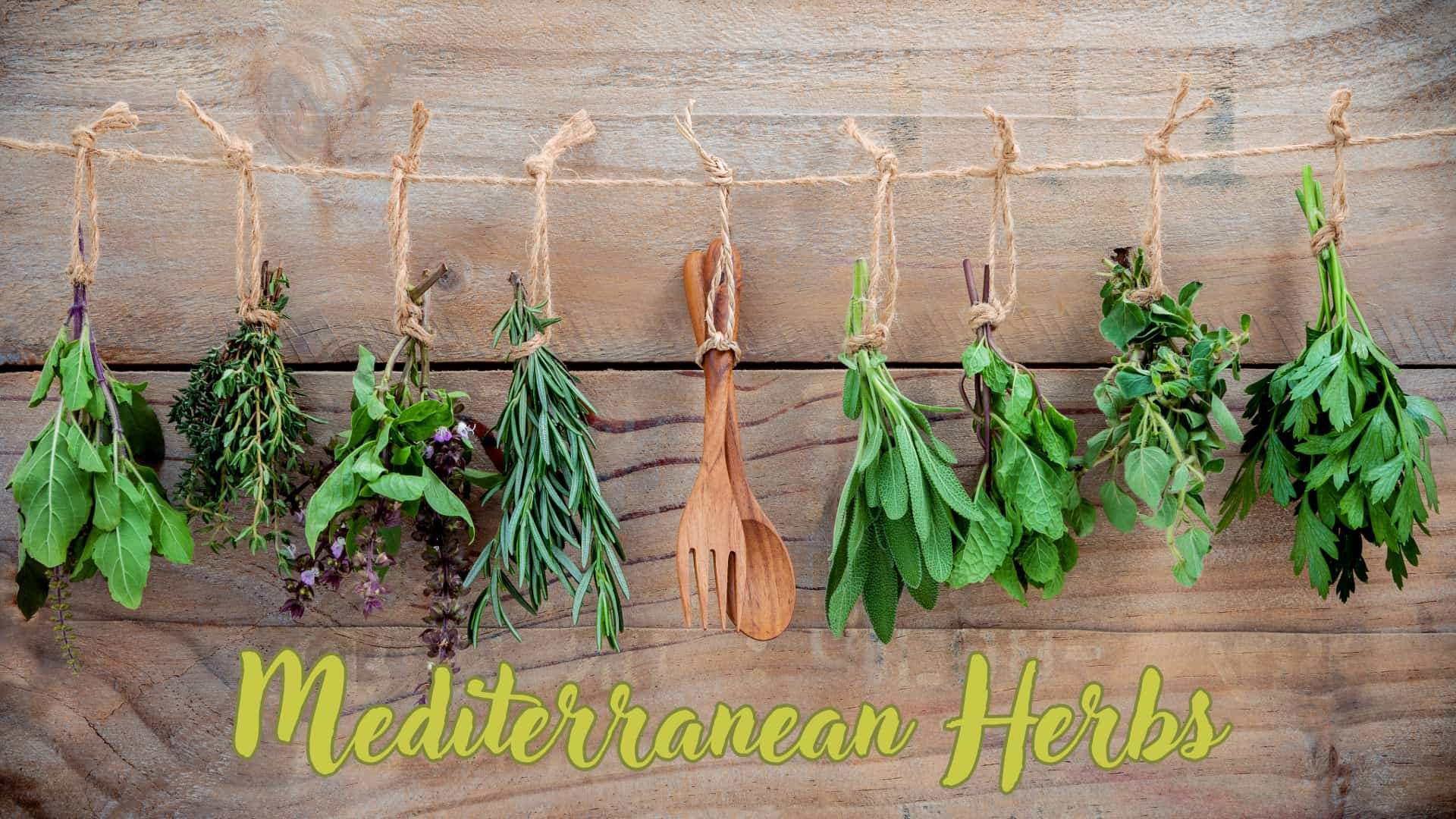
Living Up
Lessons to level up your life
Tzatziki is a creamy sauce that complements many Greek dishes and it’s perfect for dipping. For those with dietary concerns like lactose intolerance or vegan preferences, there are non-dairy alternatives available to savor this flavorful sauce without compromise.

Ah, the delight that is tzatziki! A creamy, tangy, and refreshing condiment with a hint of cucumber and garlic.
This Mediterranean gem boasts a rich history dating back centuries, originating in the regions of the Ottoman Empire, with strong roots in Greece, tzatziki is a versatile condiment enjoyed not only for its delicious taste but also for its numerous health benefits.
Its base typically consists of thick Greek yogurt, crisp cucumbers grated to perfection, minced garlic for that extra kick, a squeeze of lemon juice for zing, and a drizzle of olive oil to tie it all together.
Tzatziki’s creamy sauce complements many Greek dishes and a perfect dip. For those with dietary concerns like lactose intolerance or vegan preferences, the non-dairy alternatives available today makes this a very versatile flavorful sauce without compromise.
Tzatziki originates from the beautiful lands of the Mediterranean; some believe it dates back to the Ottoman Empire. This delightful sauce is a staple in Greek cuisine and has gained popularity worldwide for its delicious flavor profile. Its fascinating history and origin can be traced back to ancient times with certainty. Historically, tzatziki has been enjoyed for centuries as part of traditional meals in Mediterranean countries. In Greek culinary traditions, it’s a popular accompaniment to dishes such as souvlaki, gyros, and falafel.
The name “tzatziki” itself is thought to have roots in the Turkish word “cacık,” reflecting the historical influences and cultural exchanges of this sauce over the centuries. Its journey through different regions and cultures has contributed to the diverse variations of tzatziki we see today. As with many traditional recipes, each family or region may have their own unique twist on the classic ingredients.
Typically made with a base of Greek yogurt (strained yogurt if using regular), gives this signature condiment a rich and velvety texture, the fresh ingredients used in tzatziki contribute to its nutritional value, creating a harmonious blend of flavors that is both indulgent and light on the palate.
What sets tzatziki apart is its versatility – it can be used as a dip for pita bread or veggies, a sauce for grilled meats or falafel wraps, or even as a dressing for salads. Its cooling properties also make it an ideal pairing for spicy foods.
Whether you’re looking to elevate your dishes with a burst of flavor or seeking a healthier alternative to traditional condiments, tzatziki sauce checks all the boxes. Its rich history intertwined with modern culinary trends makes it a favorite among food enthusiasts worldwide!
In making the perfect tzatziki sauce, the ingredients play a crucial role in achieving that authentic Mediterranean flavor. Traditional tzatziki is typically made with a base of thick Greek yogurt, grated cucumber, fresh garlic, olive oil, lemon juice, and chopped dill.
However, if you’re looking to switch things up or cater to dietary concerns such as lactose intolerance or vegan preferences, you can use dairy-free yogurt made from coconut milk or almond milk. This swap still provides that creamy texture and tangy flavor without the dairy content. According to Megan Lavin from Allergy Awesomeness, vegan mayonnaise works great as a substitute. (Lavin, 2021)
Additionally, if you’re not a fan of dill or garlic, you can experiment with other herbs like mint or parsley to add your own unique twist. The beauty of tzatziki lies in its versatility – feel free to get creative and make it your own!
In terms of historical context, it’s interesting to note that while cucumbers have become synonymous with traditional tzatziki recipes today due to their abundance in Mediterranean cuisine, there are actually historical variations of tzatziki that don’t include cucumbers at all. These regional adaptations showcase the versatility of this beloved condiment and how it has evolved over time to accommodate different tastes and dietary concerns.

The traditional ingredients of the tzatziki sauce are loaded with healthy properties, from the yogurt to the olive oil, tzatziki is an excellent choice for a healthy diet. In researching the nutritional value of the ingredients, I learned that the DV (Daily Value) of foods indicates the “daily intake level of a nutrient that is considered to be sufficient to meet the requirements of 97–98% of healthy individuals” and it’s used to support the Reference Daily Intake (RDI) printed on nutrition facts labels (as %DV) in the U.S. and Canada, regulated by the Food and Drug Administration (FDA) and by Health Canada respectively. (Wikipedia, 2024)
Daily values are based on a 2000-calorie-a-day diet, in this post I used percentages to understand the importance of a nutrient. Actual daily nutrient requirements are different for everyone based on factors that show your uniqueness. Remember, the data on this site is informational only to make a point of its healthy value, you must consult your health advisor to achieve your specific goals. (Nutrition Value, n.d.)
Here’s the dietary information for 2 tablespoons of tzatziki. This combination of ingredients is incredibly flavorful, packed with health benefits, low in calories, and rich in probiotics from the yogurt—these live cultures in yogurt promote gut health and aid in digestion, a perfect option for those of us looking for a nutritious and delicious addition to our meals!
As a salad dressing or a dipping condiment, tzatziki is a great low-calorie accompaniment to your meals and a highly beneficial to-your-health alternative, in comparison to other dips. Tzatziki is very easy to prepare and so flexible that throughout centuries people from around the world have made a variation of tzatziki with anything they have on hand. Today we appreciate that versatility, especially for people who have specific allergies or need to replace a high-fat condiment from their diet.

The health benefits of tzatziki have long been recognized by cultures around the world for its probiotic-rich properties from yogurt, antioxidant-packed cucumbers, garlic, lemon, and dill. If you are looking for a healthy diet to help you lose weight, tzatziki is low in calories and packed with nutrients like calcium, protein, and probiotics from the yogurt.
When it comes to weight loss, incorporating tzatziki into your meals can be a game-changer. The nutrients in this sauce can help keep you full and satisfied for longer periods, reducing the likelihood of snacking on less healthy options throughout the day. Its blend of fresh ingredients and numerous health benefits make it an excellent choice for those looking to improve their diets on their journey towards achieving their ideal weight.
If you’re following a keto diet, you’ll be pleased to know that while traditional tzatziki is made with yogurt, which contains carbohydrates, opt for using non-dairy alternatives to reduce the carb content. By making this simple swap, you can enjoy the tangy flavors of tzatziki without straying from your keto goals. It’s essential to pay attention to the nutritional facts of the ingredients, for example, choose full-fat versions of non-dairy yogurts as they tend to have fewer added sugars and artificial additives compared to their low-fat counterparts.
For vegan diets, the swap in non-dairy yogurt is also recommended, these options provide a creamy texture similar to regular yogurt, making them a great base for creating a vegan-friendly tzatziki sauce. To maintain the tangy flavor that is characteristic of tzatziki, you can also add a splash of lemon juice or apple cider vinegar to the non-dairy yogurt mixture.
Consider including ingredients like tahini or nutritional yeast to enhance the creaminess and umami flavors of the dip. These additions not only contribute to the overall taste profile but also offer additional nutritional benefits, such as added protein and essential vitamins.
Just be mindful of any dietary concerns or allergies when experimenting with ingredient substitutions in your tzatziki recipe. So don’t fret if your kitchen is missing one or two items – get creative and experiment with what you have on hand to craft a unique spin on this classic Mediterranean condiment.
Start by straining the yogurt if using plain and squeezing the excess liquid with a cloth or towel. Greek yogurt may not need straining as it is naturally thicker than regular yogurt. The yogurt is then combined with grated cucumber, which adds a subtle crunch and a hint of freshness to the sauce.
Mix the grated cucumber, minced garlic, and chopped dill into Greek yogurt. If you find yourself lacking a grater for the cucumber, don’t despair – you can finely chop the cucumber instead, some use a device that can chop them finely such as a blender or food processor, but use the pulse function only so you don’t overdo it and liquify the cucumber.
To do this, peel the cucumber and cut it into small pieces. Then, using a sharp knife, mince the cucumber until it reaches a grated-like consistency. This method may require a bit more effort but will still provide that refreshing crunch in your tzatziki.

There’s no limit to how versatile and accommodating your homemade tzatziki sauce can be!
Greek yogurt may not work for lactose intolerant issues or looking to avoid dairy products altogether, however, there are plenty of non-dairy alternatives available today. You can use coconut milk yogurt or almond milk yogurt as substitutes. These options provide a creamy base for your tzatziki while catering to dietary preferences or restrictions.
Greek yogurt is the tradition, but regular yogurt works as well, and if you’re feeling adventurous and missing ingredients, why not try using ingredients you have on hand, such as vanilla yogurt? The subtle sweetness of vanilla adds an intriguing dimension to the savory notes of tzatziki, creating a delightful fusion of flavors that will tantalize your taste buds.
If you’re out of cucumber, you can replace it with zucchini, finely diced radishes, or even bell peppers for a different twist and to give your tzatziki some extra crunch.
As for dill, if you’re not particularly fond of dill or don’t have any on hand, you can opt for fresh mint or parsley as excellent alternatives. These herbs will bring their unique freshness and aroma while still complementing the tangy yogurt perfectly.
Lemon adds a vibrant citrusy kick to the sauce, but if it’s missing from your pantry, try using white wine vinegar or apple cider vinegar instead for that tangy taste. I haven’t tried it yet, but one of my favorite vinegars, the Philippino vinegar made from sugar cane (which I prefer to apple cider), would work really well for this sauce.
Garlic is another staple ingredient. If you’re out of fresh garlic try minced shallots, or even garlic powder (if you’re brave) as substitutes.
Olive oil adds richness and silkiness to the sauce and is rich in heart-healthy monounsaturated fats and antioxidants, but if you prefer to skip it altogether, you can increase the yogurt portion slightly to achieve a similar texture. I believe the extra virgin olive oil is particularly special in this sauce, but other healthy choices include avocado oil, vegan mayonnaise, and even sour cream, which is sometimes used in modern variations of tzatziki for an extra creamy consistency.
Omitting oil entirely from your tzatziki won’t ruin the dish; it will just have less richness and may be slightly thicker due to the absence of fat content.
Play around with different combinations until you find what suits your taste buds best!
Proper preservation techniques are key to prolonging the lifespan of your delectable creation. Tzatziki can be preserved in the refrigerator when stored correctly.
Homemade tzatziki can last in the refrigerator for about 3-4 days. The best way to store tzatziki by refrigeration, especially untouched (double dipping could ruin any sauce) is by placing it in an airtight container. It’s crucial to ensure that it is stored properly to maintain its freshness and prevent it from spoiling prematurely. Make sure to use a clean spoon each time you scoop some out to avoid contamination.
About the refrigerator’s lifetime, I think many of us have experienced two things, one is that it’s eaten before you get to store it. And two, if for some reason (say you made a tub) you have to refrigerate it, it will last longer as long as you don’t contaminate it by double dipping or something like that, so always use a clean spoon, or if pouring, make sure you clean the spout or rim where you poured with a clean, moderately wet, paper towel before placing back in the fridge.

Can you freeze it? The answer is a bit nuanced. The condiment will last longer but the texture will change. If you choose to freeze it use an airtight container leaving some space at the top to allow for expansion when frozen. When you’re ready to enjoy it again, just let it thaw in the fridge overnight and give it a good stir before serving.
While freezing tzatziki is possible, it’s not always recommended because the texture and consistency of the yogurt-based sauce can change once thawed. When you freeze tzatziki, the yogurt may separate, resulting in a watery or grainy texture.
Freezing is fine if you plan to use the frozen tzatziki in cooked dishes like soups or stews where the texture isn’t as crucial. Also, it can be used to marinate meats. As for thawing frozen tzatziki, remember to do it slowly in the refrigerator to minimize further separation of ingredients. Give it a good stir before serving to help reincorporate any separated components.
To ensure optimal taste and quality when using previously frozen tzatziki, always give it a taste test after thawing to see if any significant changes occurred that may affect your enjoyment of this delicious Mediterranean condiment.
Can you heat up tzatziki? The answer is a bit complex. While tzatziki is traditionally served chilled, there’s no hard and fast rule against gently heating it up if you prefer a warmer experience. The main concern when heating tzatziki is maintaining its creamy texture and avoiding separating ingredients.
Remember that part of the appeal of tzatziki lies in its cool and refreshing nature, making it an ideal condiment for various dishes without heating. Just be cautious to only bring it to room temperature or not overheat it. High temperatures may cause the yogurt base to curdle. A quick zap in the microwave in short bursts of 10 seconds and stirring, or a gentle warming on the stovetop should do the trick.
Heating tzatziki could alter its taste too, heat slowly over low heat to prevent any unwanted changes in consistency, remember that dairy products may react oddly to high temperatures.
Keep an eye out for any changes in texture or odor – if anything seems off, trust your instincts and bid farewell to that batch of tzatziki. Remember, while indulging in this creamy delight brings about numerous health benefits and nutritional goodness from its wholesome ingredients, ensuring proper storage and preservation practices will help maintain its quality and flavor for longer periods.
Can tzatziki go bad? Tzatziki is a wonderful, creamy sauce, but Like any dairy-based product, tzatziki does have a shelf life. Typically, homemade tzatziki can last in the refrigerator for about 3-4 days.
However, to determine if your tzatziki has gone bad, trust your senses. Check for any signs of mold growth or an off smell. If you notice any discoloration or an unpleasant odor, it’s best to err on the side of caution and discard the sauce. Additionally, if you see any separation or curdling in the mixture, that’s a telltale sign that your tzatziki may have spoiled.
There is a tip to freeze tzatziki to extend the shelf life, but I must share that when you make this awesome sauce, it’s usually gone very quickly, plus it may not be worth freezing when you can make your own with fresh ingredients in no time.
However, when experimenting for occasions when you need it at a later time or won’t be able to make it fresh, consider freezing portions in ice cube trays for easy use later on. To thaw the sauce you will want to do it slowly by placing it in the refrigerator, and before serving, you want to mix again making sure the texture and consistency are still holding up. Remembering these tips will help you enjoy your delicious tzatziki without any worries about it.
Tzatziki made Greek yogurt famous, and gave life to the tasteless cucumber. More garlic is used in Greece to make Tzatziki, than any other dish in our cuisine.
– The Greek Chef
Sources:
Lavin, M. (24 Jul 2021). Greek Salad With Vegan Tzatziki Sauce. Allergy Awesomeness.
Nutrition Value. (n.d.) Nutrition value, Home page.
The Greek Chef quote is from the blog TheGreekChef.us
Wikipedia. (27 Aug 2024). Reference Daily Intake. Wikipedia.





